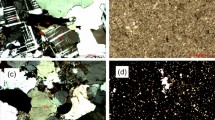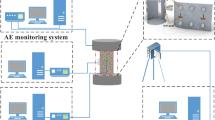Abstract
The AE energy radiated from rock microfractures is widely used to understand the rock failure process. However, the radiation energy of AE sources is usually inaccurately quantified because of imprecise knowledge of the radiation pattern associated with the tensile angle. Based on theoretical calculations, we quantify the radiation energy of the AE source more accurately by considering the influence of the tensile angle on the radiation pattern and then analyze the radiation energy evolution during the rock failure process. The energy radiation pattern and average energy radiation pattern coefficients of the P and S waves change significantly with the tensile angle. During the failure process of the granitic gneiss specimen, the radiation energy release of the rock specimen is characterized by a sudden intermittent increase in the time domain. The sudden increase is mainly due to the occurrence of large-energy AE sources rather than many low-energy AE sources in a short time. The main microfracture mechanism at the low stress level is shear compression; as the stress increases the main microfracture mechanism changes to shear. When the specimen is at failure, the shear microfractures account for > 70%.













Similar content being viewed by others
References
Aki, K., Richards, P.G. (2002). Quantitative seismology. In: Quantitative seismology, 2nd edn. W. H. Freeman, New York
Boatwright, J., & Fletcher, J. B. (1984). The partition of radiated energy between P and S waves. Bulletin of the Seismological Society of America,71, 361–376.
Chang, S. H., & Lee, C. I. (2004). Estimation of cracking and damage mechanisms in rock under triaxial compression by moment tensor analysis of acoustic emission. International Journal of Rock Mechanics and Mining Sciences,41(7), 1069–1086.
Hall, S. A., Sanctis, F. D., & Viggiani, G. (2006). Monitoring fracture propagation in a soft rock (Neapolitan tuff) using acoustic emissions and digital images. Pure and Applied Geophysics,163, 2171–2204.
Hu, X., Su, G., Chen, G., et al. (2019). Experiment on rockburst process of borehole and its acoustic emission characteristics. Rock Mechanics and Rock Engineering,52, 1023–1039.
Jiang, D., Xie, K., Chen, J., Zhang, S., Tiedeu, W., Xiao, Y., et al. (2019). Experimental analysis of sandstone under uniaxial cyclic loading through acoustic emission statistics. Pure and Applied Geophysics,176, 265–277.
Kwiatek, G., & Ben-Zion, Y. (2013). Assessment of P and S wave energy radiated from very small shear-tensile seismic events in a deep South African mine. Journal of Geophysical Research: Solid Earth,118(7), 3630–3641.
Ohtsu, M. (2008). Acoustic emission testing: basic for research-applications in civil engineering. New York: Springer.
Ou, Gwo-Bin. (2008). Seismological studies for tensile faults. Terrestrial, Atmospheric and Oceanic Sciences,19(5), 463–471.
Přikryl, R., Lokajíček, T., Li, C., & Rudajev, V. (2003). Acoustic emission characteristics and failure of uniaxially stressed granitic rocks: The effect of rock fabric. Rock Mechanics and Rock Engineering,36, 255–270.
Vavryčuk, V. (2014). Moment tensor decompositions revisited. Journal of Seismology,19(1), 231–252.
Wang, Q., Chen, J., Guo, J., et al. (2019). Acoustic emission characteristics and energy mechanism in karst limestone failure under uniaxial and triaxial compression. Bulletin of Engineering Geology and the Environment,78, 1427–1442.
Xue, Y., Dang, F., Cao, Z., Du, F., Jie, R., Xu, C., et al. (2018). Deformation, permeability and acoustic emission characteristics of coal masses under mining-induced stress paths. Energies,11, 2233.
Zhang, H., Yan, Y., Yu, H., & Yin, X. (2004). Acoustic emission experimental research on large-scaled rock failure under cycling load–fracture precursor of rock. Chinese Journal of Rock Mechanics and Engineering,23, 3621–3628. (in Chinese).
Zhang, P., Yang, T., Xu, T., Yu, Q., Zhou, J., & Zhu, W. (2018). Rock Stability assessment based on the chronological order of the characteristic acoustic emission phenomena. Shock and Vibration,2018, 1–10.
Zhang, P., Yang, T., Yu, Q., Xu, T., Zhu, W., Liu, H., et al. (2015). Microseismicity induced by fault activation during the fracture process of a crown pillar. Rock Mechanics and Rock Engineering,48, 1673–1682.
Zhao, X. G., Wang, J., Cai, M., Cheng, C., Ma, L. K., Su, R., et al. (2014). Influence of unloading rate on the strainburst characteristics of Beishan granite under true-triaxial unloading conditions. Rock Mechanics and Rock Engineering,47, 467–483.
Zhao, Y., Yang, T., Zhang, P., et al. (2019). Correction to: Method for generating a discrete fracture network from microseismic data and its application in analyzing the permeability of rock masses: a case study. Rock Mechanics and Rock Engineering (online)
Zhou, X., Peng, S., Zhang, J., Qian, Q., & Lu, R. (2018). Predictive acoustical behavior of rockburst phenomena in Gaoligongshan tunnel, Dulong river highway, China. Engineering Geology,247, 117–128.
Acknowledgements
The work presented in this paper is financially supported by the National Key Research Project (2016YFC0801607) and the National Natural Science Foundation of China (51604062, 51574060) and Fundamental Research Funds for the Central Universities of China (N180101028).
Author information
Authors and Affiliations
Corresponding author
Ethics declarations
Conflict of interest
The author(s) declared no potential conflicts of interest with respect to the research, authorship, and/or publication of this article.
Additional information
Publisher's Note
Springer Nature remains neutral with regard to jurisdictional claims in published maps and institutional affiliations.
Rights and permissions
About this article
Cite this article
Zhang, P., Yu, Q., Li, L. et al. The Radiation Energy of AE Sources with Different Tensile Angles and Implication for the Rock Failure Process. Pure Appl. Geophys. 177, 3407–3419 (2020). https://doi.org/10.1007/s00024-020-02430-2
Received:
Revised:
Accepted:
Published:
Issue Date:
DOI: https://doi.org/10.1007/s00024-020-02430-2




